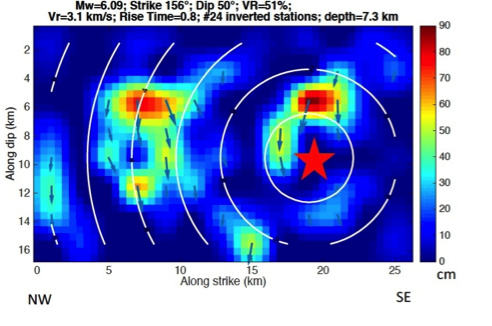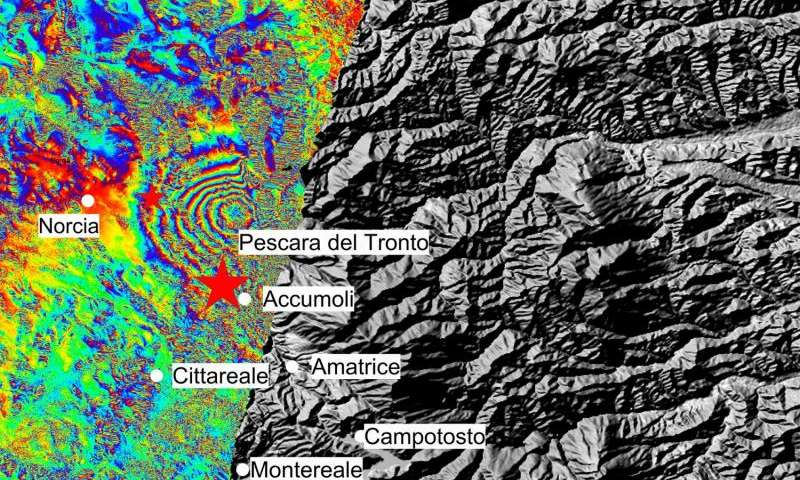Combining two Sentinel-1 radar scans from 20 August (Sentinel-1B) and 26 August 2016 (Sentinel-1A), this interferogram shows changes that occurred during the 24 August earthquake that struck central Italy.
===
http://www.ilmattino.it/napoli/cronaca/ - Ultimo aggiornamento:
Sciame sismico nei Campi Flegrei
quaranta lievi scosse in due ore,
Elisabetta
Froncillo.
===
http://phys.org/archive/16-09-2016/
A tsunami can strike any coast at any time and we can't predict exactly when
or where they will occur. Tsunamis are most often caused by
undersea earthquakes but they can also be caused by submarine landslides
or volcanic eruptions. A
tsunami can move as fast as a jet plane across the open ocean and can
smash into land with waves as high as 20 metres. The water may wash
inland for several kilometres in flat lying areas, and can move up
streams and rivers, picking up everything in its path. A tsunami can strike any coast at any time and we can't predict exactly when
or where they will occur. Tsunamis are most often caused by
undersea earthquakes but they can also be caused by submarine landslides
or volcanic eruptions. A
tsunami can move as fast as a jet plane across the open ocean and can
smash into land with waves as high as 20 metres. The water may wash
inland for several kilometres in flat lying areas, and can move up
streams and rivers, picking up everything in its path. A tsunami can strike any coast at any time and we can't predict exactly when
or where they will occur. Tsunamis are most often caused by
undersea earthquakes but they can also be caused by submarine landslides
or volcanic eruptions. A
tsunami can move as fast as a jet plane across the open ocean and can
smash into land with waves as high as 20 metres. The water may wash
inland for several kilometres in flat lying areas, and can move up
streams and rivers, picking up everything in its path.How to prepare for a tsunami
Tsunamis are most often caused by undersea earthquakes but they can also be
caused by submarine landslides or volcanic eruptions.
A tsunami can move as fast as a jet plane across the open ocean and can smash
into land with waves as high as 20 metres.
The water may wash inland for several kilometres in flat lying areas, and can
move up streams and rivers, picking up everything in its path."
Read more at:
https://theconversation.com/explainer-how-to-prepare-for-a-tsunami-64824
Many of the largest earthquakes, including the December
26, 2004 quake in Sumatra, occurred during periods when the pull of the Moon
and Sun were particularly forceful
The same gravitational force that creates high tides when the Moon and Sun
align may also play a role in triggering major earthquakes, according to a
study released Monday.
Better understanding of this mechanism could help predict when known faults
are more likely to produce killer quakes, researchers said.
"
When the tug of gravity is strongest, they added, "the probability of a tiny rock failure expanding to a gigantic rupture increases."
For centuries after the discovery that solar and lunar forces affect the ocean tides, scientists speculated whether they also cause Earth's crust to buckle and fracture.
But only recently has statistical research started to establish a firm link between planetary alignments and tremblors.
Satoshi Ide, a professor at the University of Tokyo, and colleagues zeroed in on large earthquakes—magnitude 5.5 or greater—around the world over the last two decades.
His team reconstructed the size of gravitational pull, known as "tidal stress", in the two weeks prior to each tremor.
They found no clear correlation with smaller quakes.
Many of the largest earthquakes, however, occurred during periods when the pull of the Moon and Sun were particularly forceful.
When the tug of gravity is
strongest, they added, "the probability of a tiny rock failure expanding to
a gigantic rupture increases."
For centuries after the discovery that solar and lunar forces affect the
ocean tides, scientists speculated whether they also cause Earth's crust to
buckle and fracture.
But only recently has statistical research started to
establish a firm link between planetary alignments and tremblors.
Satoshi Ide, a professor at the University of Tokyo, and colleagues
zeroed in on large earthquakes—magnitude 5.5 or greater—around the world over
the last two decades.
His team reconstructed the size of gravitational pull, known
as "tidal stress", in the two weeks prior to each tremor. They found no
clear correlation with smaller quakes.
Many of the largest earthquakes, however, occurred during periods when the pull of the Moon and Sun were particularly forceful. "The new results, Ide told AFP -
derived from a statistical analysis of a large number of tremblors - cannot explain why some small quakes turn into mega ones at Spring tide, while others do not."
=== http://phys.org/archive/23-09-2016/
Seismic 'CT scans' reveal deep earth
dynamics
| September 23, 2016 | by Wallace
Ravven
"Different evidence has led to three different plate movement scenarios: either the plates are pushed from mid-ocean ridges; or they are pulled from their subducting slabs;
or their movement is driven by the drag of the viscous mantle material that lies directly below."
Odds of mega-quake rise at high tide: study
September 12, 2016
The same gravitational force that creates high tides when the Moon and Sun align may also play a role in triggering major earthquakes, according to a study released Monday.
Better understanding of this mechanism could help predict when known faults are more likely to produce killer quakes, researchers said.
"Large earthquakes are more probable during periods of high tidal stress," the scientists concluded in the peer-reviewed journal Nature Geoscience.
~!~ ~!~ ~!~
La sequenza
sismica in Italia centrale a un mese dal suo inizio: un
aggiornamento sugli studi in corso
| 2016
Set 23 |
Pubblicato da
blogingvterremoti


